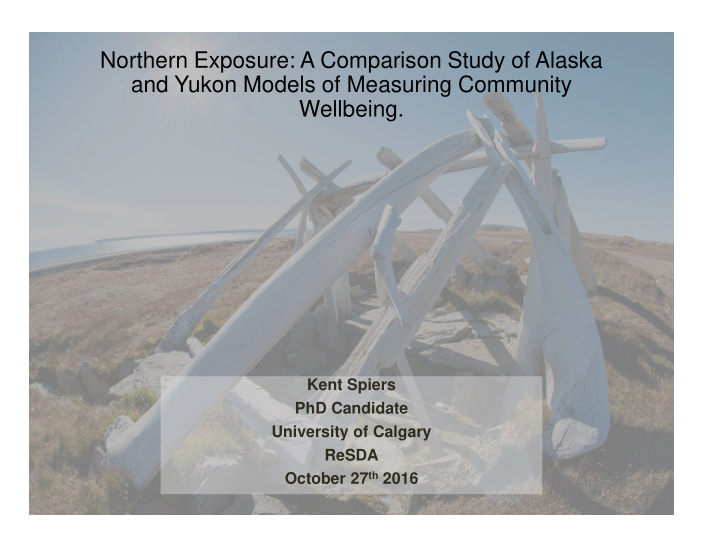



Northern Exposure: A Comparison Study of Alaska and Yukon Models of Measuring Community Wellbeing. Kent Spiers PhD Candidate University of Calgary ReSDA October 27 th 2016
Question What are the similarities and difference in models of measuring community wellbeing in Alaska and the Yukon ? What was the level of local input in the construction of the models?
Introduction • Research suggests that communities successful in establishing an agreed upon model of measuring community wellbeing will benefit from local ownership of community affairs, such as greater decision-making, a larger capture of material wealth, and empowerment over resource management. • This thesis highlights the need to investigate models in the Arctic that address; the clash between mainstream and Indigenous measures of wellbeing, the lack of accurate and longitudinal data, remoteness, lack of infrastructure, and small population sizes.
The Notion of Wellbeing • Rooted in philosophic perspectives of hedonic and eudemonic traditions. (Ryan and Deci 2001) • NASA • 60’s: Department of Health, Education, and Welfare called for wellbeing to include health and illness. • Gross National Happiness. • 70’s: Social Indicators Movement included both economic and non- economic indicators of wellbeing. • WHO
Definition of Wellbeing The combination of social, economic, environmental, cultural and political conditions identified by individuals and their communities as essential for them to flourish and fulfill their potential. (Center for Spirituality & Healing and Charlson Meadows 2013).
Model of Measuring Community Wellbeing
Methods 1. Assessment of the level of local input from community residents. • Reviewed publications related to each model. • Asked respondents about their involvement in particular models. • Checked background information for each model
2. Experimental Content analysis using keywords from the literature and supported by respondents. Alaska and Yukon Frequency Counts Combined 2833 774 539 447 421 349 256 251 210 180 156 151
3 . Qualitative analysis of interviews. Pseudonym Gender Region of Study Occupational background • Conducted 8 interviews. John Male Alaska Environmental Anthropologist • Transcribed and coded into themes Patsy Female Alaska Biologist • Definitions of Estelle Female Alaska Economist Community. Rose Female Yukon Community Capacity Wellbeing, Indicators Consultant to measure wellbeing, Dennis Male Alaska Resource Development social ills, culture, Consultant aboriginal peoples, education and Betty Female Alaska Anthropologist employment. Eddie Female Yukon Community Development Specialist Dorothy Female Alaska Educator
List of Models Name Region Organization Type of Indicators Eagle Gold Project Central Yukon Victoria Gold Corp. Quantitative & Qualitative Yukon Social Inclusion and Yukon Territory Government of the Yukon. Quantitative & Qualitative Poverty Reduction Strategy Department of Health and Social Services Community Wellbeing Index Canada – focus on Yukon Aboriginal Affairs and Quantitative findings for this study. Northern Development Canada Shareholder Employment at North West Arctic Borough, Institute of Social and Quantitative Red Dog Mine Alaska Economic Research Anchorage Economic Live. Work. Play. Municipality of Anchorage Quantitative Development Corporation Destination 2020 Municipality of Anchorage Anchorage School District Quantitative
Health Alaska and Yukon Frequency Counts Combined 2833 774 539 447 421 349 256 251 210 180 156 151
Health “I think everyone in my community is depressed.” “We need to have trained people to actually deal with the trauma that we are going through. We have suicide, alcohol, very risky behaviors and chronic diseases. We need education and then start implementing our own cultural ways to address these issues.”
Overall Results • Most models used limited or no local input. • Community members need to be included in all aspects of model design. Those not consulted felt resentment or totally rejected the model. • Models need to incorporate both objective and subjective indicators (e.g. GDP, income, self-reported levels of satisfaction with community services, and happiness and worry) that are agreed upon by community members. • There is growing tension around the lack of direct action and funding to improve local living conditions.
Results in Action? Shorefast foundation Fogo Island, Newfoundland
“A dream for my community would be to have a holistically healthy community; where people are laughing and smiling because they feel good and where peoples’ basic needs are met and our people don’t have to struggle with past issues of abuse or addictions. Where there is an open forum for them to discuss those things.” – Diyet van Lisehout
Thank you Kent Spiers, PhD Candidate University of Calgary Arctic Institute of North America kspiers@ucalgary.ca
Recommend
More recommend